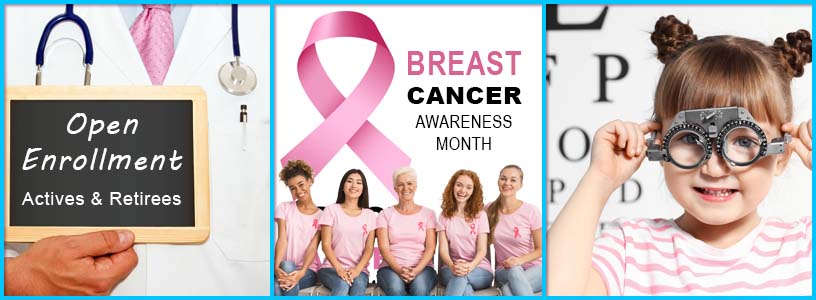SCHEDULE A MAMMOGRAM: October is Breast Cancer Awareness Month
Cancer doesn’t stop for COVID-19, but most cancer screenings came to a screeching halt in 2020, and mammograms were canceled for millions of women. Now, mammograms are readily available, but not everyone has gotten back on schedule with routine screenings.
That means many women are now living with undetected breast cancer.
Breast cancer is the second most common cancer among women in the U.S., causing 42,000 deaths each year. Mammograms can change that by catching potential issues as early as possible, increasing the chances of successful treatment and survival.
Women who are 50 to 74 years old and are at average risk for breast cancer should get a mammogram every two years. Women who are 40 to 49 years old should talk to their doctor about when to begin screening. Your Health Plan covers 100% of preventive screenings within these guidelines.
On October 18, National Mammography Day, do something for your good health and schedule an appointment for your next mammogram.
Resources from your Health Plan
- Kaiser Permanente: Everything you need to know about mammograms
- Providence: Now is the time to get screened
- Regence: Breast cancer: Early detection
- Cigna (for Substitute Teachers): About mammograms
CHILDREN’S EYE EXAMS: Now More Important Than Ever
Throughout 2020, many children were learning through online programs and spending much more time on screens than they did prior to the pandemic. Prolonged screen time can cause digital eye strain, as well as a higher rate of myopia (nearsightedness) progression.
Up to 80% of a child’s learning is visual, so even the slightest vision problem can have a negative impact on their academic achievement.
Comprehensive eye exams are the best way to correct vision problems and detect eye health conditions. (Don’t solely rely on vision screenings provided by schools, which only identify a limited number of vision problems.)
Routine Eye Exams are important for every member of the family, especially for those who spend a good portion of their day in front of a screen. Eye exams detect vision problems, eye health issues, and chronic conditions like diabetes and high blood pressure.
If you are eligible for vision coverage, here’s how your vision plan covers eye exams:
- Kaiser Permanente Vision Plan (for Kaiser Permanente Medical Plan participants): You pay $5 copay per exam; then the Plan pays 100%. Learn more here: Vision Essentials
- VSP Vision Plan (for all other medical plan participants): You pay $0 when you choose a VSP provider; the Plan covers one exam every 12 months. Learn more here: Eye Health & Wellness
OPEN ENROLLMENT FAQs: Got Questions? We Have Answers
Open Enrollment for Active Employees and Early Retirees continues through Friday, October 28, 2022. Click here to enroll right now.
Here are the top questions we get asked:
- Do I need to enroll this year? YES, if you want to change your current benefit selections, have a Flexible Spending Account (FSA) in 2023 (Active employees) or if you aren’t currently enrolled but want benefits in 2023
(January 1 – December 31) . - Do I need to enroll if I want to keep my current selections? NO, your current benefit choices will roll over to the 2023 Plan Year (except FSAs). However, Open Enrollment is a great time to review and update your eligible dependents.
- What are my current benefit selections?
- Active employees: Log in to selfservice.pps.net with your PPS username and password. Or you can contact the PPS Benefits Department by email at benefits@pps.net or by phone at
503-916-6464 . - Early Retirees: Log in to Zenith American’s Participant Edge. Check your current enrollment, eligibility, and enrolled dependents, and send/receive secure messages with the Trust Administrative Office. Or you can contact the Trust Administrative Office by phone at
833-255-4123 (toll free) or503-486-2107 .
- Active employees: Log in to selfservice.pps.net with your PPS username and password. Or you can contact the PPS Benefits Department by email at benefits@pps.net or by phone at
- Where can I review the benefit options? Your Open Enrollment Packet (mailed to you in early October and posted on sdtrust.com) provides everything you need to compare your options.
- How do I know which dependents are already enrolled?
- Active employees: Log in to selfservice.pps.net with your PPS username and password. Or you can contact the PPS Benefits Department by email at benefits@pps.net or by phone at
503-916-6464 . - Early Retirees: Log in to Zenith American’s Participant Edge. Check your current enrollment, eligibility, and enrolled dependents, and send/receive secure messages with the Trust Administrative Office. Or you can contact the Trust Administrative Office by phone at
833-255-4123 (toll free) or503-486-2107 .
- Active employees: Log in to selfservice.pps.net with your PPS username and password. Or you can contact the PPS Benefits Department by email at benefits@pps.net or by phone at
- Which dependents are eligible to enroll? Click here: Eligible Dependents
- What if I don’t enroll or update my benefit selections by the deadline? When will I have another opportunity? If you don’t enroll or update your benefits by the deadline, you won’t have another opportunity to do so until the next Open Enrollment period (fall 2023) unless you have a qualifying life event.
If you have any benefits questions, including how the Trust Plans coordinate with other coverage, please call the Trust Administrative Office before you enroll.


